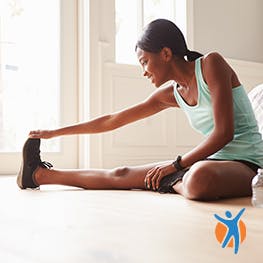
SHARE THIS ARTICLE:
Poor posture could be the reason why your back hurts, so sit up straight and read on to find out why and how to improve your posture.
From shoulder pain caused by hunching over a smartphone, to lower back pain from sitting at our desks all day, it’s no surprise that we suffer from back pain and posture issues. Who hasn’t had to call in sick at work because of back pain, or put off a night out with friends because they were in too much pain to have a good time?
When asking yourself how to improve posture, there are a few simple steps you can take to ensure you don’t have to miss an important meeting or an evening of fun because of back pain and posture.
What do we mean by posture?
Posture refers to the way in which your body is positioned when you are sitting, moving or standing. As well as being vital for our movement and comfort, having a good posture means that muscles and ligaments are not working harder than they should.1
What does this have to do with back pain?
Skeletal muscle is made up of two types of muscle fibre – static (often called 'slow twitch') and phasic (often called 'fast twitch'). Generally, static muscle fibres are found in the deeper muscle layers. They help us to maintain posture without too much effort and contribute to balance by ‘sensing’ our position and relaying this information to the brain. Phasic muscle fibres are used for movement and activity.
Static fibres burn energy slowly and can keep working for a long time without tiring. However, phasic fibres quickly run out of steam. Poor posture causes muscle fatigue because it calls on the phasic fibres instead of static fibres to maintain the body’s position.1

40% of people believe their pain affects their ability to interact with others.*

89% of people felt less motivated at work as a result of their pain*
How do I know if I have bad posture?
Some signs of bad posture you may be able to see, including rounded shoulders, a pot belly or a tendency to jut your head forward. Others you will feel: back pain, body aches and pains, muscle fatigue or headache.1
Don’t worry, it’s easy to improve your posture!
A good posture should feel effortless – there’s no need to throw your shoulders back and stick your chest out. If your muscles are tight or weak, it may take some time to adjust your posture habits at first, but these small changes can make a big difference to back pain and posture.
Try this quick posture check
When you’re standing up, you should be able to imagine a straight line running from your ear through your shoulder, hip and knee to the middle of your ankle.
There are a number of simple ways in which you can help to improve your posture. While it may take some time and feel awkward at first to correct a posture that you are accustomed to, your back will thank you.
Stop slouching
If you have a tendency to slouch when sitting, with your pelvis further forward than your shoulders, your muscles have to work harder, resulting in tension and pain.2 Avoid soft chairs for long periods – while they seem comfortable, they make it difficult to maintain a good posture.1
To correct this posture, try exercises that will strengthen your core, buttocks, shoulder and neck muscles, such as back extensions.2

How to do back extensions
- Lie on your stomach, and bring your arms beneath you, bending your elbows so your hands are resting on the floor under your face
- Keep your shoulders back and neck in line with your spine
- Arch your back up by pushing down on your hands until you feel a gentle stretch on your stomach muscles
- Hold for 5 to 10 seconds, breathing all the time
- Return to start position
- Repeat 8 to 10 times3
- Stop immediately if you feel any pain or discomfort

Stand square
If you’ve ever worked in a shop, as a hairdresser or in a restaurant, you’ll know that standing all day can be tiring. It’s common to stand with one leg out and your weight over the other, especially if you have been on your feet for a while. Although it seems comfortable, it places uneven strain on your hips and lower back, and can lead to muscle imbalances and pain in your lower back.2
You can work on correcting uneven hips with exercises to strengthen your buttocks, lower back and core muscles, such as the plank.2
How to plank
- Lie on your front, then raise your body on your toes and bent forearms
- Keep your legs straight and hips raised to create a straight line from head to toe
- Your shoulders should be directly above your elbows
- Make sure you keep your tummy muscles tight throughout the exercise
- Hold this position for 5 to 10 seconds and repeat 8 to 10 times to strengthen your core muscles4
- Stop immediately if you feel any pain or discomforts

Sit up straight
Poor posture is common among office workers, many of whom can sit for hours at a desk without moving. When you’re concentrating on a task, it’s easy to ignore discomfort.1 Spending long periods looking down at a smartphone can similarly, create the modern syndrome of ‘text neck’.2 Over time, the chest muscles tighten and the back muscles become weak, which can cause rounded shoulders and back stiffness. It’s important to take regular breaks to stretch, move around and ensure you are sitting correctly.5
Here’s a handy tip
When you’re at work, set an alarm to remind you take a two minute break from your desk every 30 minutes.5
Sit in a stable chair to properly support your lower back. Your knees should be at right angles or a little lower than your hips, with your feet either supported by a footrest or flat on the floor. Having your feet firmly positioned provides support for your back.5
So now you know why it matters and how to improve your posture. While you are going about your daily business, occasionally pause for a second to give yourself a check. Your back will thank you for it in the long run.
Health, wellness & your pain
Pain is rarely just physical nor is it always solved by taking medicine alone. Voltaren is your ally in helping you take more control of your pain journey, from the way to sleep, to what you eat, mental wellbeing and complementary pain relief therapies.











